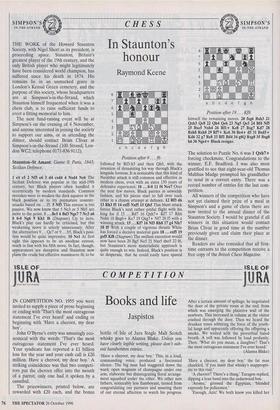SIMPSON'S
IN-THE-STRAND
SIMPSON'S
IN•THE•STRAND
In Staunton's honour
Raymond Keene
THE WORK of the Howard Staunton Society, with Nigel Short as its president, is proceeding apace. Staunton, Britain's greatest player of the 19th century, and the only British player who might legitimately have been considered world champion, has suffered since his death in 1874. His remains lie in an unmarked grave in London's Kensal Green cemetery, and the purpose of this society, whose headquarters are at Simpson's-in-the-Strand, which Staunton himself frequented when it was a chess club, is to raise sufficient funds to erect a fitting memorial to him.
The next fund-raising event will be at Simpson's on the evening of 4 November, and anyone interested in joining the society to support our aims, or in attending the dinner, should contact Brian Clivaz at Simpson's-in-the-Strand (100 Strand, Lon- don WC2; telephone 0171-836 9112).
Staunton—St Amant: Game 8; Paris, 1843; Sicilian Defence.
1 e4 c5 2 Nf3 e6 3 d4 cxd4 4 Nxd4 Nc6 The Sicilian Defence was popular in the mid-19th century, but Black players often handled it eccentrically by modern standards. Common mistakes were to weaken the dark squares in the black position or to try premature counter- attacks based on ... f5. 5 Nt3 This retreat is too passive. We now know that 5 Nc3 or 5 Nb5 are more to the point. 5 ... Bc5 6 Bd3 Nge7 7 Nc3 a6 8 0-0 Ng6 9 Khl f6 (Diagram) Up to here, Black's play can hardly be criticised, but this weakening move is utterly unnecessary. After the alternatives 9 ... Qc7 or 9 ...b5, Black's posi- tion would be quite impressive. 10 Nel At first sight this appears to be an anodyne retreat, much in line with his fifth move. In fact, though, appearances are deceptive and Staunton now plans the crude but effective manoeuvre f4, to be Position after 9 . . f6 followed by Rf3-h3 and then Qh5, with the intention of dynamiting his way through Black's kingside fortress. It is noticeable that this kind of Neolithic attack is still common and effective in modern chess, even with an extra 150 years of defensive experience. 10 ...0-0 11 f4 Nce7 Over the next few moves, Black parries in unwieldy fashion, and his pieces start to fall over each other in a clumsy attempt at defence. 12 Rf3 d6 13 Rh3 15 14 exf5 NxfS 15 Qh5 This blunt attack forces Black's next rather pitiful flight with his king for if 15 ... Bd7 16 Qxh7+ Kf7 17 Rh6 Nxh6 18 Bxg6+ Ke7 19 Qxg7+ Nf7 20 f5 with a winning attack. 15 ...K.17 16 NO Rh8 17 g4 Nfe7 18 f5 With a couple of vigorous thrusts White has forced a decisive material gain 18 ...exf5 19 gxf5 Kf8 (Diagram) The swiftest execution would now have been 20 Bg5 Ne5 21 Nxe5 dxe5 22 f6, but Staunton's more materialistic approach is quite enough to win. Indeed, Black's position is so desperate, that he could easily have spared Position after 19 . . . Kf8 himself the remaining moves. 20 fxg6 Bxh3 21 Qxh3 Qc8 22 Qh4 Qe6 23 Ng5 Qe5 24 Bf4 Nf5 25 BxeS Nxh4 26 Rfl+ Ke8 27 Bxg7 Kd7 28 Bxh8 Rxh8 29 Rf7+ Kc6 30 Be4+ d5 31 Bxd5+ Kd6 32 g7 Re8 33 Rfl Bd4 34 gliQ Rxg8 35 Bxg8 h6 36 Nge4+ Black resigns.
The solution to Puzzle No. 6 was 1 Qxh7+ forcing checkmate. Congratulations to the winner, E.F. Bradford. I was also most gratified to see that eight-year-old Thomas Malthus Madge prompted his grandfather to send in a correct entry. There was a record number of entries for the last com- petition.
All winners of the competition who have not yet claimed their prize of a meal at Simpson's and a game of chess there are now invited to the annual dinner of the Staunton Society. I would be grateful if all winners in this situation would contact Brian Clivaz in good time at the number previously given and claim their place at the dinner.
Readers are also reminded that all first- time entrants to the competition receive a free copy of the British Chess Magazine.


















































































 Previous page
Previous page